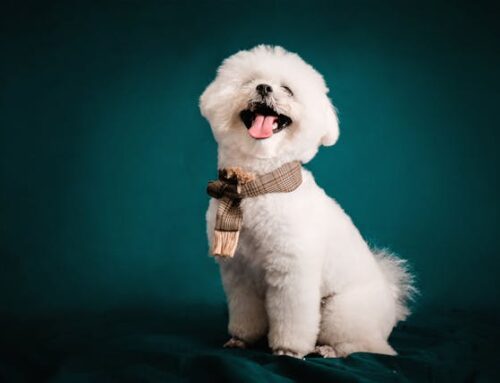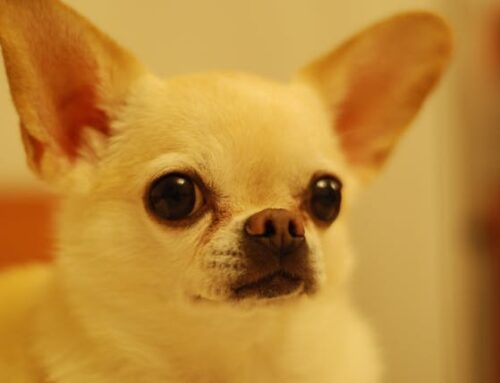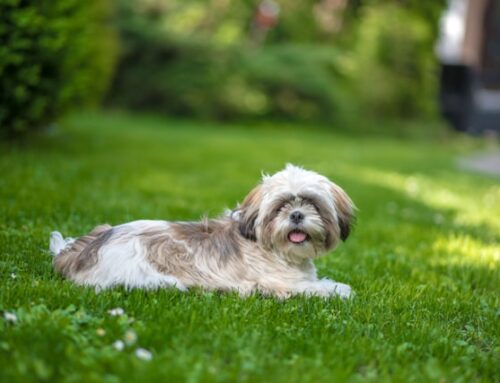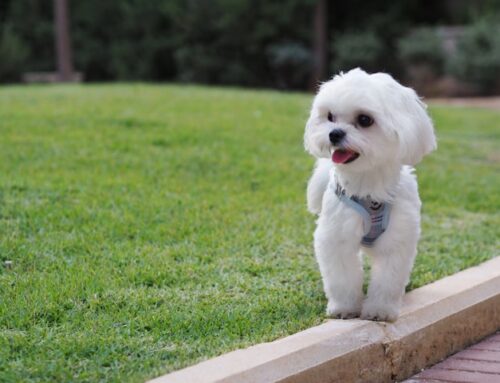Overview
Introduction: Do Poodles Shed
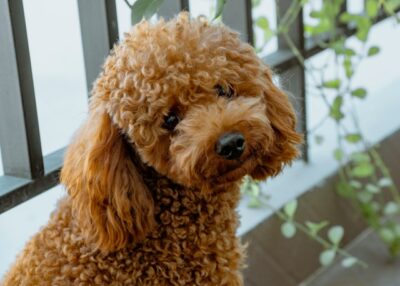
Ever wondered, do poodles shed? The straightforward answer is yes, poodles do shed, but their unique coat efficiently collects shed hair, creating the illusion of minimal shedding.
This article delves into how the distinct fur of a poodle impacts shedding, drawing parallels between poodle shedding and human hair loss. We’ll explore the composition of a dog’s skin and coat, providing insights into how poodle shedding differs from that of most dogs. Delving into the specifics, we’ll address questions such as how much poodles shed, the frequency of poodle shedding, and what makes them generally recognized as a hypoallergenic dog breed.
Understanding the nuances of poodle shedding becomes essential in assessing potential allergen exposure. Additionally, we’ll touch on the grooming practices required to maintain the health of their curly coat and manage shedding effectively. So, if you find yourself pondering, ‘do poodles shed?’ – this article has the answers you’re looking for, exploring the intricacies of poodle shedding and their unique attributes.
Key Takeaways: Do Poodles Shed
- Poodle sheds, but their curly coats trap the hair, making it less noticeable and lowering the spread of allergens, which is why they’re considered hypoallergenic.
- The type and size of a Poodle (Standard, Miniature, Toy) influence its shedding pattern, with larger Poodles shedding more in volume and all needing regular grooming.
- Poodle hair has a longer growth cycle than many breeds, which contributes to less frequent shedding, and they don’t follow a seasonal shedding pattern like many other dogs.
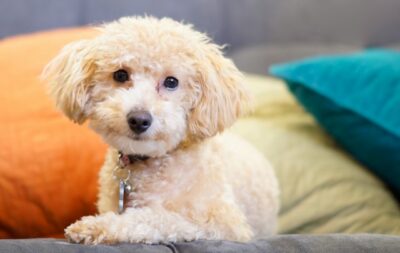
Shedding Truths: Unraveling the Poodle Coat Mystery
Poodles have distinct shedding characteristics that set them apart from other breeds. One common question among potential dog owners is, ‘Do Poodles shed?’ The answer lies in understanding the unique nature of their coat. Poodles boast a curly and dense coat that effectively traps shed hair within it, creating an impression that they do not shed much. However, it’s essential to recognize that, like all dogs, Poodles do experience shedding.
The difference with Poodles lies in the fact that their fur tends to stay inside until brushed out, giving the perception of being a low-shedding breed. This distinct trait not only makes cleaning easier for owners but also contributes to why Poodles are often considered hypoallergenic dogs, making them suitable companions for those with allergies.
The curly and low-shedding coats of Poodles, coupled with minimal drooling tendencies, result in reduced allergen release into the environment when compared to other dog breeds. It’s crucial to note that there isn’t a universal type of coat found on Poodles; multiple variations exist, each having an impact on how much or little these pooches will shed.
For those curious about the intricacies of a Poodle’s coat and shedding patterns, exploring the different types of Poodle coats becomes enlightening. Understanding these aspects sheds light on why Poodles are unique in their shedding behavior, making them a popular choice for individuals seeking a canine companion with minimal shedding and allergen impact. Discover the fascinating world of Poodle sheds and their diverse coat variations within this remarkable dog breed.
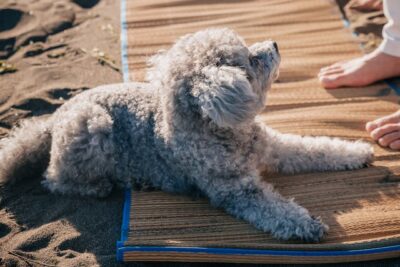
The Curly Coat Phenomenon
The curly coat is one of the most defining characteristics of a Poodle. This distinctive feature serves more than just an aesthetic purpose. The curls in their coat have a practical function as well – they trap shed hair and prevent it from falling all over the place. This not only leads to less dog hair around your home, but also reduces the likelihood of triggering allergic reactions.
To keep your pet’s coat clean, free from tangles and healthy, regular grooming is essential in order to remove trapped dog hair and prevent excessive shedding. Not only does this benefit the overall appearance of your poodle, but also helps maintain a hygienic living environment for both you and your beloved furry companion.
Hypoallergenic Qualities
Poodles are often praised for their hypoallergenic qualities, which can be attributed to their thick and curly fur. This type of coat effectively traps allergens and prevents them from being released into the environment at high levels, unlike many other dog breeds. It’s important to note that no breed is completely free of allergens, even with consistent grooming efforts. But poodles do have significantly lower amounts. Thanks to their unique coat structure.
Poodle Coat Types
It may surprise you to learn that there are various coat types within the Poodle breed. This is largely due to the size of a Poodle, as it can impact their shedding tendencies.
To better understand this, let’s take a look at how Standard, Miniature and Toy Poodles differ in terms of their coats. Each type possesses its own unique characteristics when it comes to fur texture and shedding frequency.
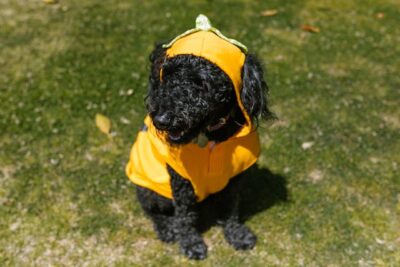
Standard Poodle
Be among the tallest with the Standard Poodles! These dogs are considered the biggest in all types of poodle breeds and have a thick, curly fur that ranges from tight waves to corkscrew curls.
Because of their large size, standard poodles also possess a denser coat which results in more shedding compared to smaller varieties.
Miniature Poodle
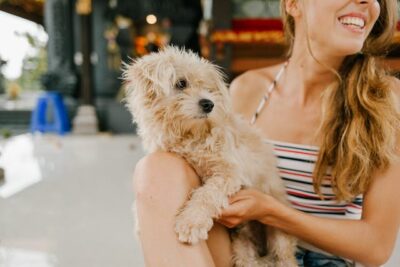
Now, let’s move on to the Miniature Poodles. Even though they are smaller than Standard Poodles, these adorable pups still have a dense and curly coat that is typically coarser in texture. Due to their size, they do not shed as much as Standard Poodles, but it is important to regularly groom them in order for their coat to look its best.
Toy Poodle
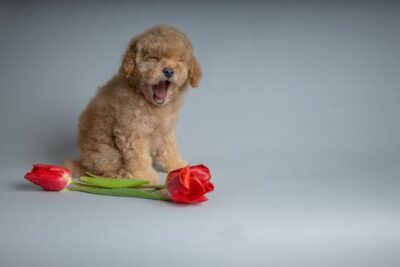
The final breed we will discuss is the delightful Toy Poodle. These tiny dogs have a curly coat that continuously grows, meaning they need consistent grooming to maintain their coat’s well-being and manage shedding effectively. Don’t let their small size fool you, proper care for this distinctive type of dog includes regular grooming sessions.
Understanding Poodle Hair Dynamics
To learn about the various types of coats, it is important to understand the distinctive hair growth cycle of Poodles. Unlike other breeds, Poodles have a longer period for their hair to grow, resulting in less shedding and adding to their hypoallergenic nature.
Hair Growth Cycle
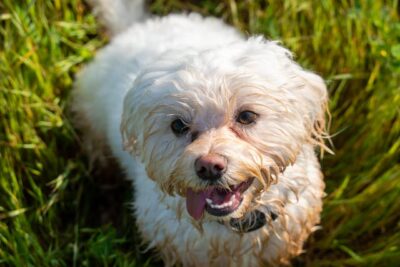
The growth process of poodle hair is divided into three phases: anagen (active), catagen (transition) and telogen (resting). Unlike other breeds with shorter hair cycles, the extended duration of Poodle’s anagen phase allows for continuous hair growth similar to that of humans. This unique characteristic results in a reduced amount of shedding compared to other dogs.
Comparing Shedding: Poodles vs. Other Breeds
Poodles are easily distinguishable from other dog breeds not only because of their unique hair growth cycle but also because of their distinct coat. The curly texture of the poodle’s fur traps loose strands, resulting in less shedding and reduced release into the environment. This makes them a top choice for those who suffer from allergies, as Poodles are considered a low-shedding breed with minimal impact on allergy sufferers.
The question often arises: ‘Do Poodles shed?’ The answer lies in understanding the practical nature of their coat. While all dogs shed to some extent, the curly structure of a Poodle’s hair minimizes the shedding process, keeping loose strands contained within the curls.
This characteristic coat is not only visually appealing but also makes Poodles popular pets, particularly for individuals prone to allergies. The reduced shedding and limited release of allergens into the environment contribute to their reputation as a breed with minimal impact on allergy sufferers.
Grooming Essentials for Poodle Coat Health

Proper maintenance of their unique coat and managing shedding is important for Poodles to maintain a healthy appearance. Consistent grooming not only prevents tangles, mating, and plaque accumulation, but also promotes skin health while reducing the chances of irritation or illness.
Brushing Techniques
Grooming a Poodle’s fur can be quite the task. To do it properly, follow these steps:
- Begin by using a gentle brush designed for detangling.
- Take care of any knots or tangles you come across.
- Use a slicker brush to remove any loose hair remaining in the coat.
- Remember to always brush in the direction that the hair grows, starting from the head and moving downwards.
5.. It is important to thoroughly comb through all layers of fur so as to effectively eliminate mats and tangles close to skin level.
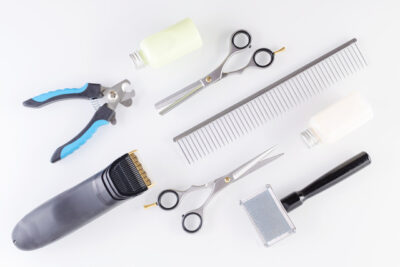
Selecting the Right Grooming Tools
Properly choosing grooming implements is crucial when maintaining a Poodle’s coat. Slicker brushes, pin brushes, steel combs, and dematting brushes are all necessary tools to have on hand for keeping your purebred poodle looking its best. Regular brushing not only helps in managing shedding but also prevents matting and tangling, ensuring a healthy and aesthetically pleasing coat.
When selecting grooming tools for your poodle, it is also important to consider their comfort. Opting for brushes and combs with noise reduction capabilities can minimize stress during the grooming process, creating a more positive experience for both the dog and the owner. This is especially important when dealing with a poodle’s shedding, as a relaxed grooming session contributes to the overall well-being of your pet.
In addition to choosing the right grooming implements, using a high-quality dog shampoo is essential for maintaining a poodle’s coat. Selecting a shampoo that suits your poodle’s specific needs, whether for sensitive skin or to enhance coat shine, plays a vital role in overall grooming. Regular baths using appropriate dog shampoo contribute to skin health, which in turn influences the shedding patterns of your poodle.
For dog lovers who understand the unique requirements of poodle grooming, the process becomes a bonding experience. Brushing your poodle not only keeps their coat in optimal condition but also fosters a strong connection between the owner and the pet. So, when it comes to caring for your beloved poodle, investing in the right tools, using quality dog shampoo, and approaching grooming as a positive activity will undoubtedly enhance the experience for both you and your furry companion.
Professional Grooming: When to Seek Expert Care
Regular visits to a professional groomer are essential for maintaining the health of your Poodle’s coat. While at-home grooming is important, having your Poodle professionally cleaned ensures thorough cleansing and can also help detect any underlying skin issues early on.
Benefits of Regular Professional Grooming
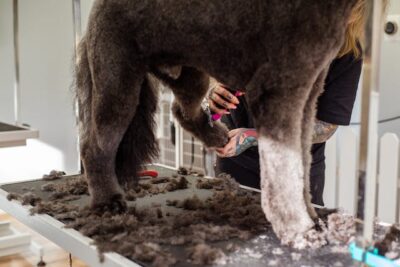
Having your puppy regularly groomed by a professional has several advantages. Not only does it guarantee that their fur remains clean, but also prevents any potential skin irritations and eliminates the risk of ear infections caused by excessive hair growth. Skilled groomers can provide your Poodle with an attractive haircut that accentuates their unique character while promoting overall coat health.
Diet and Exercise: Vital Roles in Coat Maintenance
The condition of a Poodle’s coat, much like humans, is greatly impacted by the combination of a well-balanced diet and consistent physical activity. For a poodle puppy, providing a nutritious diet containing necessary vitamins and minerals is essential to support healthy coat growth. A proper diet, coupled with regular exercise, plays a crucial role in preserving the shiny and healthy appearance of a Poodle’s fur.
Owners of purebred Poodles, and particularly those concerned about shedding hair or potential hair loss, can benefit from paying extra attention to their Poodle’s diet and exercise routine. A balanced diet not only contributes to overall health but also influences the quality of the coat. Regular exercise helps stimulate blood circulation, promoting a vibrant and well-maintained coat.
For those who groom their Poodle regularly, the connection between diet, exercise, and coat health is crucial. Brushing your Poodle is not just about aesthetics; it also aids in distributing natural oils, removing loose hairs, and promoting a healthy coat. This is particularly important for managing shedding and reducing the likelihood of triggering dog allergies.

Healthy Diet for Optimal Coat Health
To ensure a puppy’s coat stays healthy, it is crucial to provide them with a diet rich in protein, fats, vitamins and minerals. Both Omega-3 and Omega-6 fatty acids are known for their beneficial effects on skin and coat health. Incorporating these nutrients into your dog’s diet can help promote a lustrous coat while also minimizing shedding.
Exercise Impact on Skin and Coat
In order to maintain your dog’s coat health, it is just as important to have a regular exercise routine as it is to watch their diet. By engaging in physical activity, blood circulation increases and this helps the natural oils in their coat spread evenly, resulting in a lustrous and healthy appearance.
After exercising outdoors with your Poodle, remember to clean their paws thoroughly. This simple act can prevent potential skin problems from arising later on.
Poodle Varieties and Their Shedding Habits
As previously mentioned, Poodles come in various sizes and each has its own type of fur with different shedding tendencies. The amount of shedding a Poodle does is influenced by their size, as larger ones typically have more hair to shed due to their bigger coat area.
Standard Poodles: A Closer Look
Standard Poodles, being the largest type of poodle breed, have a greater coat volume which can lead to more shedding. Their dense and curly fur has the ability to trap loose hair effectively resulting in minimal amounts released into their surroundings.
Miniature and Toy Poodles: What to Expect
In contrast, the shedding of Miniature and Toy Poodles is minimal because their coats are smaller in size. It may occur less frequently and be less noticeable compared to other breeds, but it is still important to regularly groom them for both coat health maintenance and managing any shedding that does occur. This holds true especially for toy poodles who have even smaller coats than miniature ones.
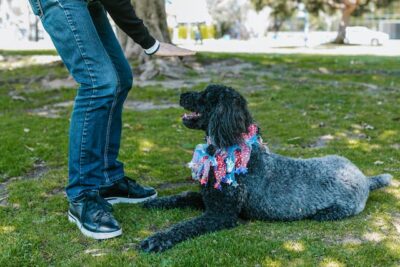
Seasonal Shedding: Do Poodles Follow a Pattern?
Unlike some other breeds, Poodles do not have a specific time of year where they shed more. Rather, their shedding is consistent throughout the whole year, but may be slightly increased in spring and fall. If your Poodle spends most of its time indoors and experiences constant temperature changes, it may continue to shed consistently all year round.
Managing Shedding in Poodle Mixes
If you have a hybrid Poodle, remember that the amount of shedding may vary depending on the other breed mixed in. The characteristics and frequency of coat shedding for crossbred dogs are heavily influenced by genetics.
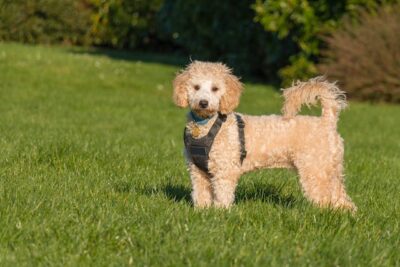
Addressing Common Skin and Coat Issues
Poodles, known for their distinctive coat, may face typical skin and coat problems which should be promptly taken care of to ensure the health of their fur.
Preventive measures include maintaining a balanced diet and regular exercise to frequent grooming sessions.
Recognizing Signs of Skin Infections
Being able to identify the indications of skin infections is essential for keeping your puppy in good health. If you observe red, irritated and swollen skin on your Poodle or if they are constantly licking or gnawing at their fur, it could be a sign of a skin infection.
Strategies to Prevent Matting and Tangles
The unique texture of a Poodle’s fur makes it susceptible to knotting and snarling. Consistent brushing and proper grooming with appropriate instruments can effectively ward off these problems and maintain your Poodle’s coat in optimal condition.
Nurturing Your Poodle’s Sensitive Skin
Proper care is crucial for the sensitive skin of Poodles. This includes regularly grooming with products that are hypoallergenic, incorporating a diet high in omega-3 and omega-6 fatty acids, as well as ensuring they get enough exercise to promote healthy skin.
Poodle Shedding Myths Debunked
Despite popular belief, Poodles do shed. Their shedding process is unique due to the characteristics of their coat and hair growth cycle. To other breeds.
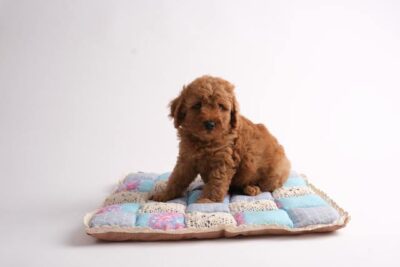
Conclusion: Do Poodles Shed
Throughout this guide, we have delved into various topics related to the distinctive shedding characteristics of Poodles. We have also discussed how proper grooming practices, diet choices, and regular exercise all play crucial roles in maintaining a healthy coat for your beloved Poodle.
We trust that our comprehensive coverage has provided you with valuable insights on understanding the intricacies of poodle shedding as well as equipping you with essential care tips for their unique coats.
Closing thoughts
While Poodles may require more grooming than some breeds, their distinctive shedding pattern, known as “poodle shed,” makes them an ideal choice for those with allergies or a preference for low-shedding pets. The unique nature of poodle’s hair, characterized by its curly and dense texture, contributes to the hypoallergenic quality of their coat.
Understanding the way poodles shed is crucial for effective grooming and maintenance. Contrary to common belief that poodles don’t shed, they do, but the shedding is minimal and often unnoticeable due to the hair getting trapped in the curly coat. This makes them suitable companions for individuals who are sensitive to allergens associated with pet hair.
Proper grooming plays a pivotal role in managing poodle shedding. Regular brushing not only helps in removing loose hairs but also prevents matting and tangling, ensuring a well-maintained coat. The health of the dog’s skin is equally important, as it directly influences the quality of the dog’s coat. Incorporating a balanced diet and appropriate skincare measures contribute to overall skin health.
It’s important to remember that a well-groomed dog is a happy one. By understanding the intricacies of poodles shedding, pet owners can tailor their grooming routines to keep their poodle’s coat in optimal condition. So, whether you are a seasoned poodle owner or considering adopting one, embracing the unique aspects of poodles shed will undoubtedly enhance your experience with these wonderful, low-shedding companions.

Summary: Do Poodles Shed
To summarize, poodles are low-shedding dogs compared to other breeds because of their curly coat and unique hair growth cycle. The question of ‘Do poodles shed?’ is often asked, and the answer lies in understanding the practical nature of their coat. While all dogs shed to some extent, poodles shed in lesser amounts due to the structure of their coat.
To maintain a healthy poodle coat, it is important to groom them regularly using appropriate tools like slicker brushes or pin brushes. Regular grooming not only helps prevent matting but also aids in distributing natural oils, contributing to the overall health and shine of the coat. This grooming routine, combined with providing a balanced diet and regular exercise, plays a crucial role in preserving the low-shedding quality of a poodle’s fur.
While people often think of a poodle as a hypoallergenic dog due to their minimal shedding, it’s important to note that no dog breed is entirely allergen-free. However, the reduced shedding of poodles, thanks to the structure of their coat, makes them a popular choice for individuals prone to allergies. If you’re considering bringing a poodle into your home, explore our selection of poodle puppies for sale in Georgia and surrounding areas. Find your perfect furry companion today!
Common Questions
Do you still have questions about shedding in poodles? We’ve put together a list of commonly asked questions to help clarify this topic for you. These answers will provide insight into understanding the process and patterns of shedding specifically in poodles, so keep reading! If you’re wondering, ‘Do poodles shed?’ – find the answers you seek to make an informed decision about welcoming a poodle into your home.
Frequently Asked Questions – Do Poodles Shed
- Do Poodles Shed?
- Poodles are often considered a low-shedding breed. Their curly coat minimizes loose hair, making them a popular choice for individuals with allergies.
- What Causes Poodles to Shed?
- Poodles shed minimally due to their unique curly coat. While no dog is completely non-shedding, Poodles shed less than other breeds.
- How Should I Care for My Poodle’s Coat?
- Regular grooming is essential for a Poodle’s coat health. Brush your Poodle with a pin brush and a grooming schedule can help prevent matting and keep the coat in good condition.
- Is Shedding More Common in Poodle Mixes?
- Poodle mixes, or doodles, may inherit coat characteristics from the non-Poodle parent. While some may shed less, it varies, and regular grooming is still crucial.
- What About Poodle Puppies and Shedding?
- Poodle puppies may shed baby fur as they grow, but this is a normal process. Their adult coat will typically be more evident as they mature.
- Can Poodles Cause Allergies?
- Poodles are often considered hypoallergenic, as their coat structure reduces the likelihood of triggering allergies in some individuals. However, individual reactions may vary.
- Does Coat Color Affect Shedding in Poodles?
- The shedding patterns of a Poodle’s coat remain consistent, irrespective of the color variation. Whether you have a light-colored poodle or a dark one, the degree of shedding remains relatively unaffected by the color of the coat.
- Are Purebred Poodles Less Likely to Shed?
- Purebred Poodles are generally consistent in their shedding patterns. Responsible breeding helps maintain the breed’s characteristics, including the coat’s low-shedding nature.
- How Can Many Poodle Owners Minimize Shedding?
- Regular and frequent brushing helps remove loose hairs and stimulates blood circulation in the skin. This practice contributes to a healthy coat and minimizes shedding.
- Is the Poodle Recognized by the American Kennel Club?
- Yes, the Poodle is recognized by the American Kennel Club (AKC) as a standard breed with specific coat and grooming standards.
- Is the Poodle Considered a Non-Shedding Breed?
- While no dog is entirely non-shedding, Poodles are often labeled as a low-shedding or hypoallergenic breed due to their curly coats.
- What Grooming Tools Should I Use for My Poodle?
- A pin brush is recommended for Poodles, along with other grooming tools. Regular brushing and proper grooming equipment help maintain the coat and skin health.
- How Important is a Regular Grooming Schedule for Poodles?
- A consistent grooming schedule is crucial for Poodles. Frequent brushing, along with professional grooming sessions, helps prevent matting, skin irritation, and excessive shedding.

